It‘s super easy to make authentic and homemade Japanese Miso Soup! In this recipe, I show you how to make quick and easy soup stock (dashi) from scratch, then create classic miso soup with tofu and wakame seaweed. It‘s delicious and has many health benefits.
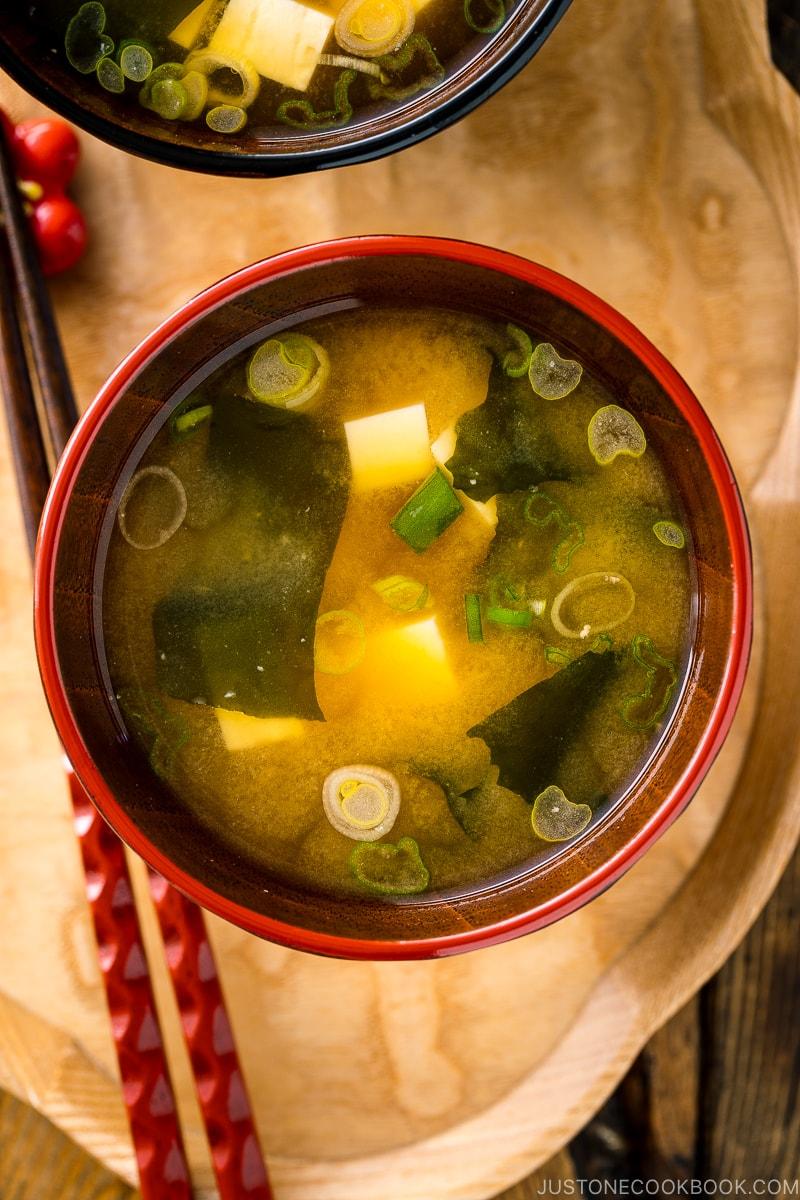
Miso soup is a staple in Japanese cuisine and is soup for the soul. We enjoy it almost every single day for breakfast, lunch, or dinner. As a Japanese home cook, I would also say that miso soup is probably one of the easiest soups you can make at home.
There are many paths to making miso soup, but once you grasp the basics, you can explore and customize. This post aims to equip you with all the essential knowledge to make yourself a bowl of authentic miso soup at home any time of the day. And trust me, what you make will taste 10,000 times better than the miso soup from Japanese restaurants or the instant varieties.

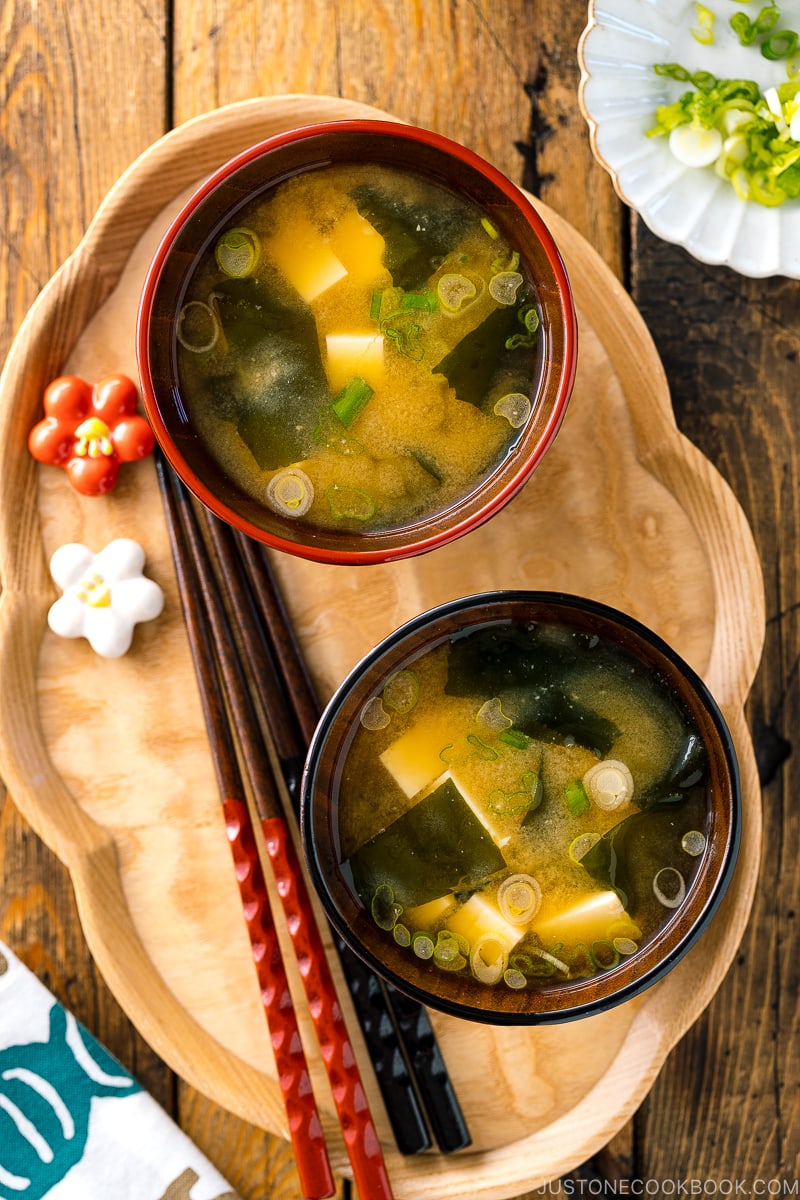
Best Miso Soup Recipe
Most Japanese meals are served with a small bowl of steamed rice and a traditional Japanese soup called Miso Soup or Misoshiru (味噌汁). At its most basic, miso soup is simply made of three components:
- Dashi (Japanese soup stock)
- Miso (Japanese soybean paste)
- Soup ingredients of your choice, such as tofu and wakame seaweed
Depending on the region, season, and personal preference, we can make many kinds of miso soup. In addition to the classic tofu and wakame combination I’ll show you today, we also use different savory ingredients such as root and leafy vegetables, meat, and seafood to enhance the soup. That’s why we can never get bored with it.
In this post, I will guide you through the most authentic miso soup recipe and explain how it all comes together in detail.
If you are already familiar with making miso soup, check out my Seasonal Miso Soup Recipe Collection.

3 Simple Steps to Make Miso Soup
Making miso soup is simple, easy, and quick! Let’s master the basic miso soup with tofu and wakame seaweed. Here is the overview of the three steps:
- Make dashi (Japanese soup stock) [20 minutes]
- Add miso [2 minutes]
- Add tofu and wakame and serve [3 minutes]
Once you know how to make this classic Japanese miso soup, you can easily create endless variations by changing the ingredients.
Now let’s dive into each step.
What is Dashi?
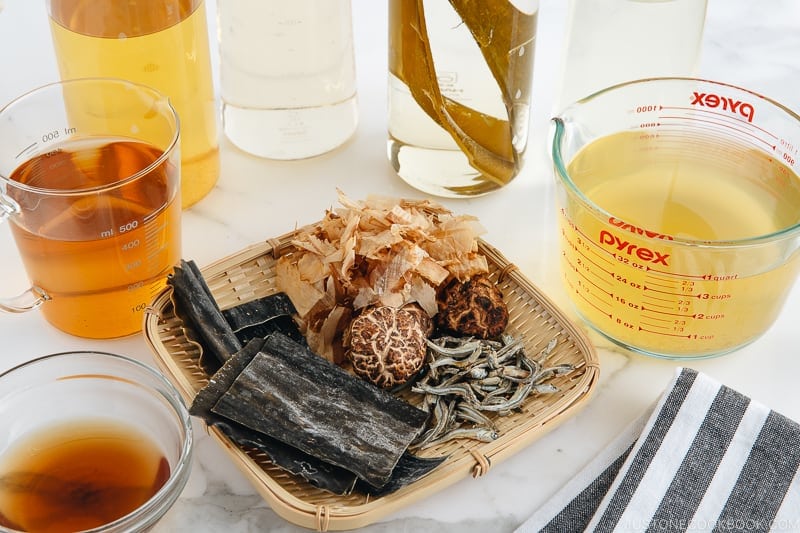
Dashi (だし・出汁) is a Japanese soup stock and the base of many Japanese dishes. It is the easiest and quickest broth to make. To make authentic Japanese miso soup, you must use dashi as the soup broth and not chicken stock or vegetable stock. Remember, without dashi, it’s not miso soup.
The most common and basic dashi is Awase Dashi, which is made with kombu (kelp) + katsuobushi (dried bonito flakes). Another popular dashi used for miso soup in Japan is Iriko Dashi, made with anchovies.
How to Make Dashi
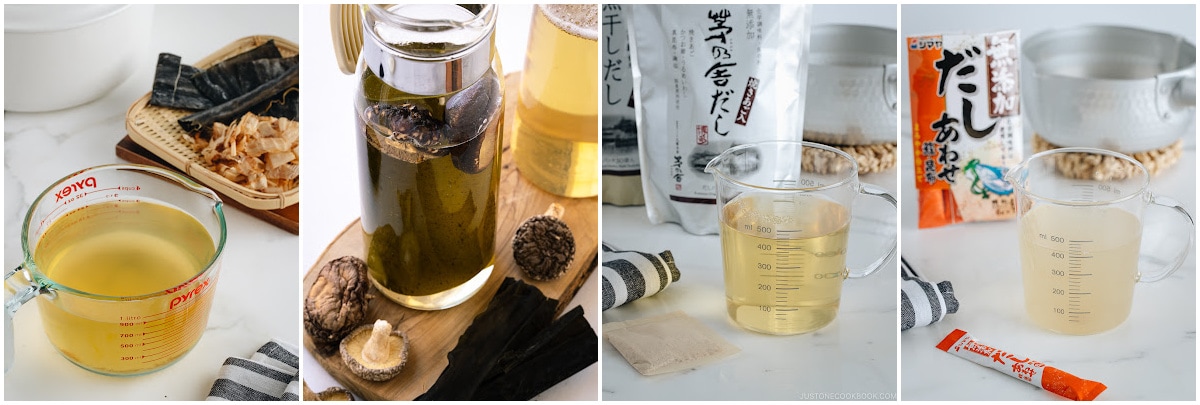
In general, there are three ways to make dashi.
- Homemade dashi — You can make a basic Awase Dashi from scratch by steeping kombu (edible kelp) and katsuobushi (dried bonito flakes) in water. If you’re vegetarian/vegan, use Kombu Dashi or make Vegan Dashi with kombu and dried shiitake mushrooms.
- Dashi packet — The dashi packet is the best shortcut method that I use often. Similar to making tea, you steep the dashi packet in water and cook for a couple of minutes. Despite its quick method, the flavor of dashi is pretty good.
- Dashi powder — Dashi powder (dashi granules) is my least favorite method due to its lack of flavor. The flavor and fragrance do not last long. But you can make a quick dashi with just dashi powder and hot water.
In this recipe, I’ll show you how to make both Kombu Dashi (vegan-friendly) and Awase Dashi from scratch!
Best Miso Paste for Miso Soup

Miso (味噌) or fermented soybean paste is made from soybeans, grains (steamed rice or barley), salt, and koji culture (麹, a fermentation starter).
There are many different types of miso in the market. In the US, most miso available at mainstream grocery stores goes by colors, such as white miso (shiro miso), red miso (aka miso), and yellow miso (awase miso or mixed miso). If you want to learn more about miso, check out our detailed post.
Each miso paste and brand varies in saltiness and flavor. When it comes to miso soup, there is no “right” miso for your miso soup. Taste and adjust the miso amount. You can mix two to three miso brands/types for more complex flavors or enjoy its unique characters using just one type, especially if you have good-quality miso.
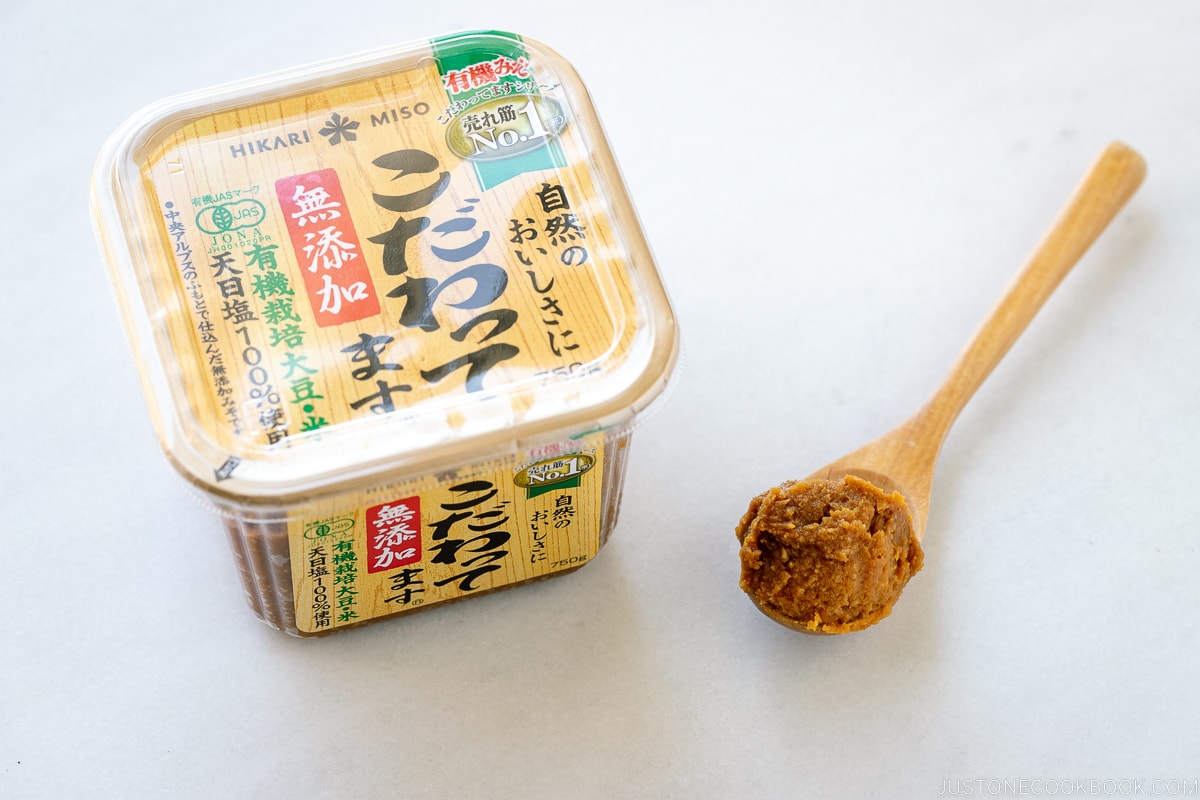

My favorite miso is this Kodawattemasu from Hikari Miso (organic slow-aged red koji miso). It has a more rounded character that goes well with any ingredients. If you want to make miso from scratch, check out How to Make Homemade Miso post.
How Much Miso Paste to Add to the Soup?
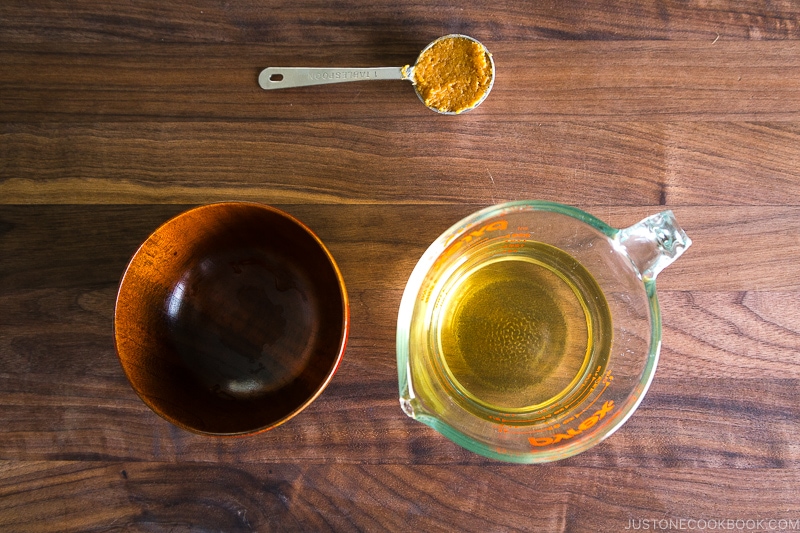
A general rule of thumb in Japan is to add one tablespoon (18 g) of miso paste per miso soup bowl, which holds 200 ml of dashi.
If you are using a US cup, use one tablespoon of miso per cup (240 ml) and add more after tasting it.
How to Dissolve Miso
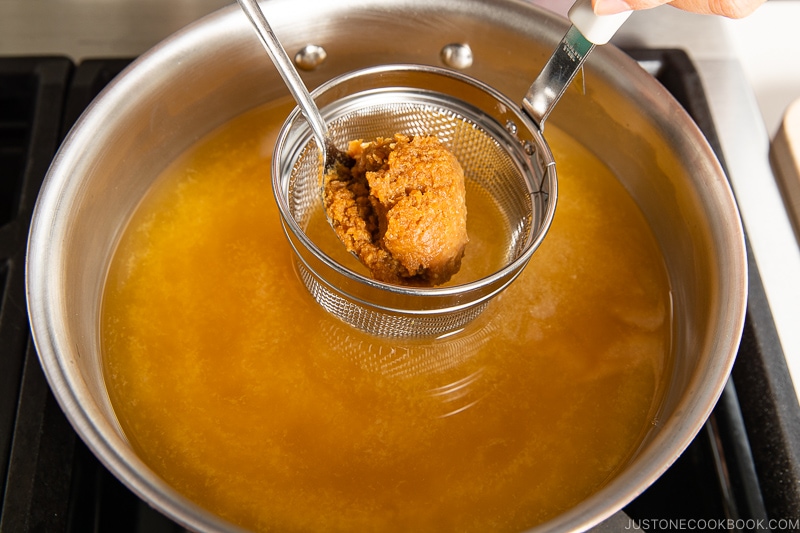
Make sure to turn off the stove’s heat so you don’t accidentally boil the miso soup. Always dissolve miso paste first in a ladle, a separate bowl, or a strainer, and never add miso paste directly to the soup! Otherwise, you may find miso clumps while drinking the soup!
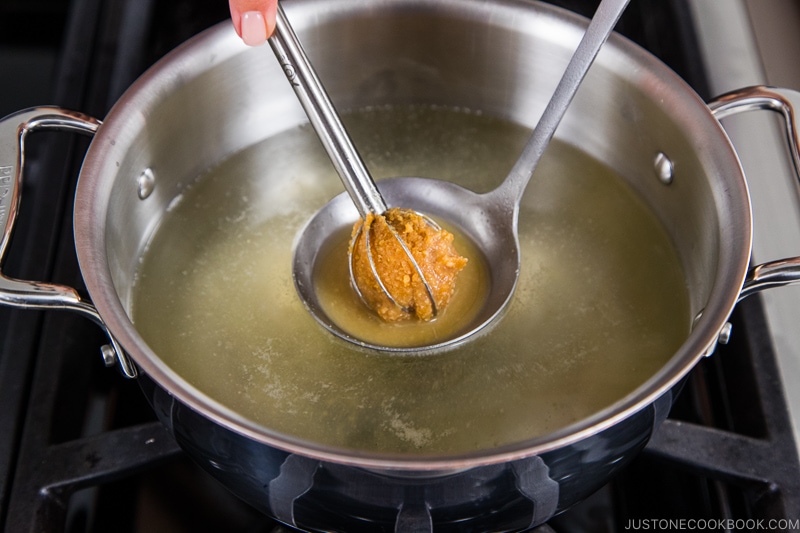

You can get my favorite Miso Muddler (One side of the whisk measures 2 Tbsp and the other 1 Tbsp) and a fine-mesh strainer to help dissolve miso.
When to Add Tofu to the Soup
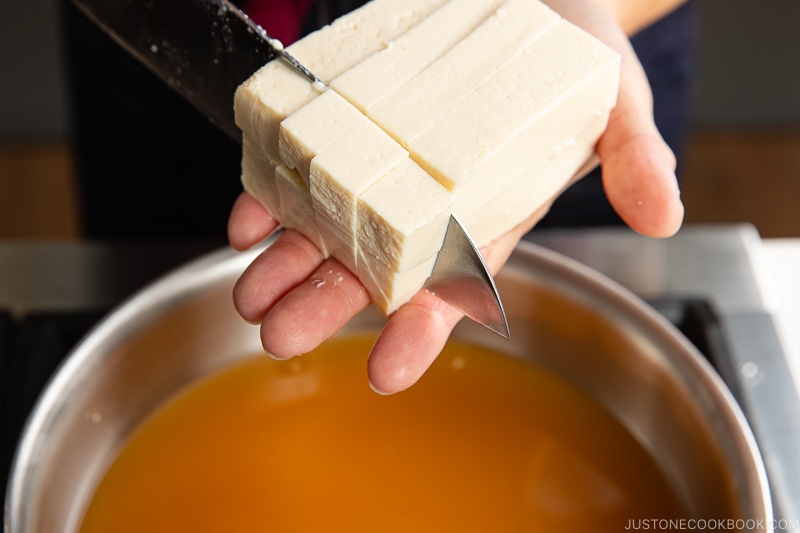
How about the tofu? We always add tofu after dissolving miso. This way, you won’t accidentally break up the tofu while mixing in the miso paste. Besides tofu, dried wakame seaweed and green onions are also added at the same time.
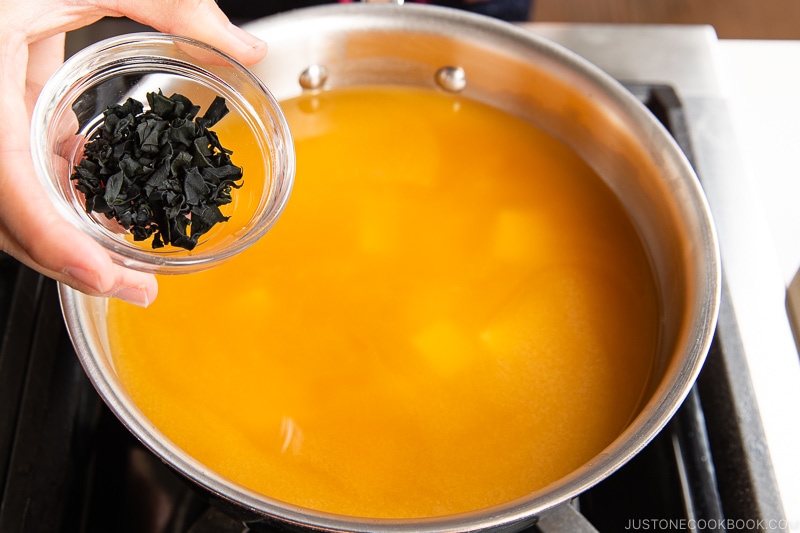
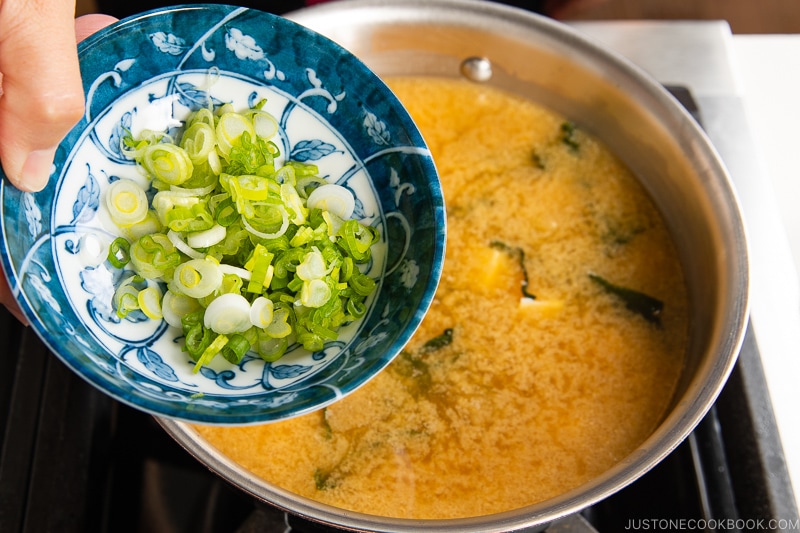
Tofu warms up nicely with the remaining heat (unless you put a lot of it) as it doesn’t require “cooking” it. (Did you know it’s edible out of the package? Try Chilled Tofu and Tofu Salad recipes!) Be careful, when you overheat tofu, the water content inside the tofu will seep out, resulting in hardened tofu.
After adding tofu, wakame seaweed, and green onion, serve miso soup immediately while it’s warm. By the time you are ready to enjoy the soup, it is an ideal temperature (167ºF or 75ºC) for drinking.
Types of tofu: You may wonder what type of tofu works best for miso soup. There is a misconception that you have to use silken/soft tofu for miso soup, but that’s not true.
You can use silken or soft tofu (kinugoshi tofu 絹ごし豆腐) for a custardy texture and medium to medium-firm tofu (momen tofu 木綿豆腐) for a spongy texture. In Japan, silken tofu is a slightly more popular choice than medium tofu, but both types of tofu are equally used in miso soup.
Reheating Miso Soup
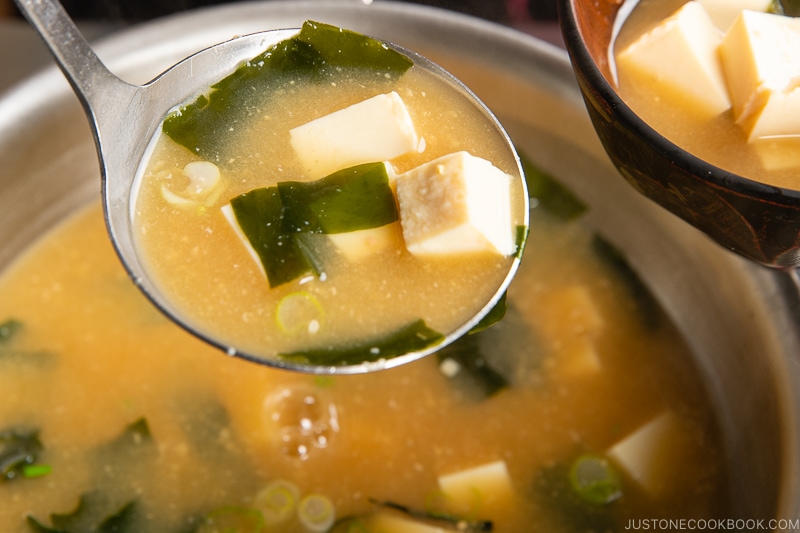
If your miso soup is no longer warm, reheat it until simmering (190°F/88°C) and NEVER boil it. Miso soup will lose its flavor and aroma (nothing to do with probiotics—see below).
If you are reheating the leftover miso soup, add about 1 tablespoon (18 g) of miso to the soup (you may need to add more dashi or water). This way, you can enjoy the warm aroma of freshly dissolved miso.
How to Store Miso Soup
In general, it‘s best to consume all the miso soup right away because it will lose its aroma and taste as time passes. If you like to keep the leftover, let your miso soup cool to room temperature (up to 4 hours; any longer and it will spoil) and then refrigerate. You can keep it for up to 2 days in the refrigerator. You can freeze miso soup for up to 2 weeks. However, you have to remove the tofu before freezing as the texture will change.
To reheat, see the above section for reheating tips.
If you want to make a big batch to store for later, it‘s best to refrigerate the soup without adding the miso. When ready to use, add the miso paste only for the portion you need.
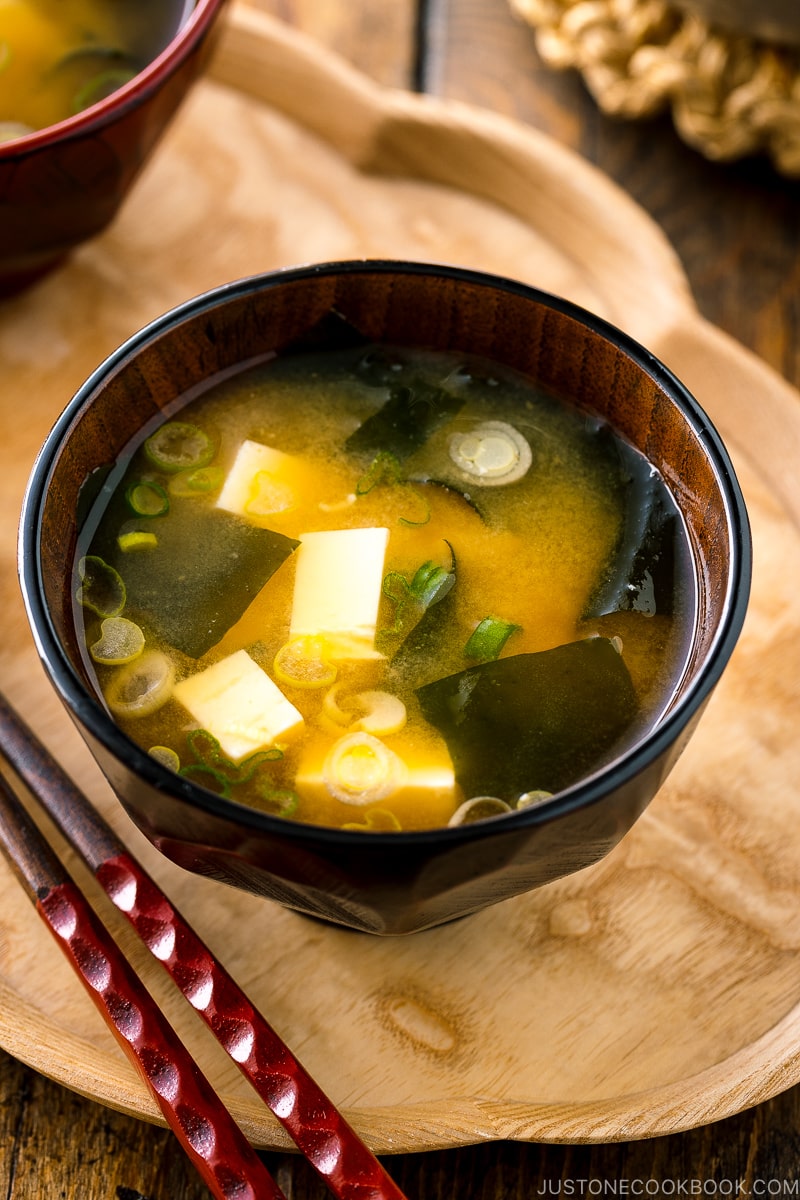
Key Points to Remember
- You can make a big batch of dashi and keep it in the refrigerator for 3-5 days.
- Add miso right before serving. Not mealtime yet? Wait until you’re ready to serve.
- Bring dashi to a slow boil (205°F/96°C), turn off the stove’s heat, and add miso. This temperature is the most fragrant stage for miso soup. By the time you enjoy the soup, it is an ideal temperature (167ºF or 75ºC) for drinking.
- Use one tablespoon per cup or miso soup bowl (200ml) and adjust the taste. Dissolve miso first in a ladle, a separate bowl, or a miso strainer to avoid clumps in the soup.
- Add tofu after dissolving miso (as well as wakame and green onion).
- Never boil miso soup because it loses its flavor and aroma.
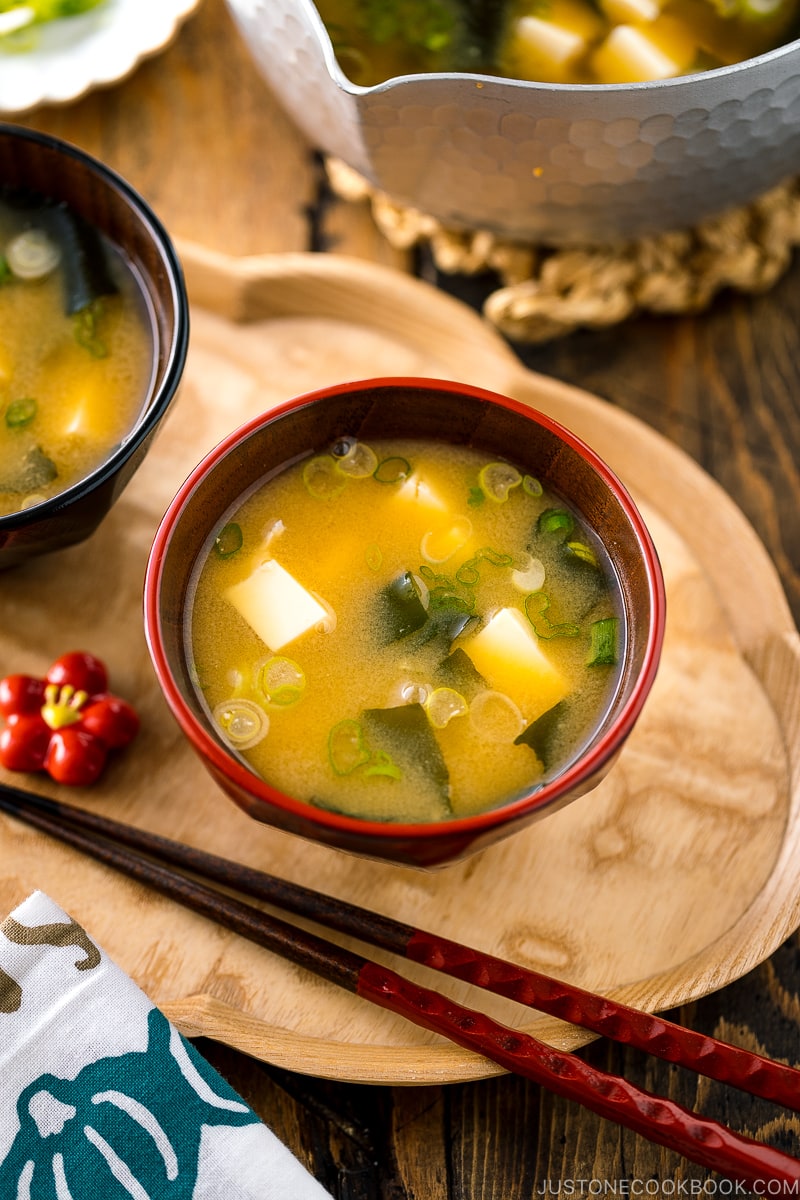
Advanced: Incorporating Other Ingredients in Miso Soup
This is a bit more advanced topic, but I’d like to give a quick introduction to it here.
If you’re using root vegetables, place them in cold dashi and cook until they become tender, approximately 10-15 minutes, depending on the vegetable’s density and cut.
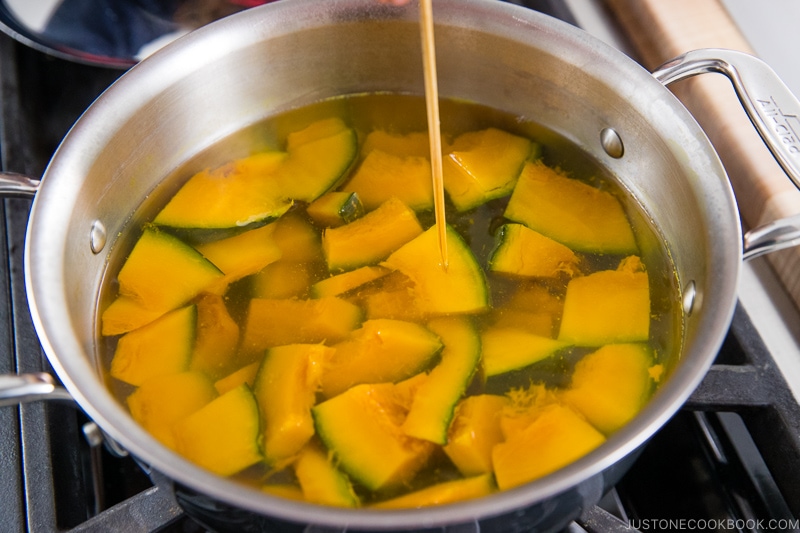
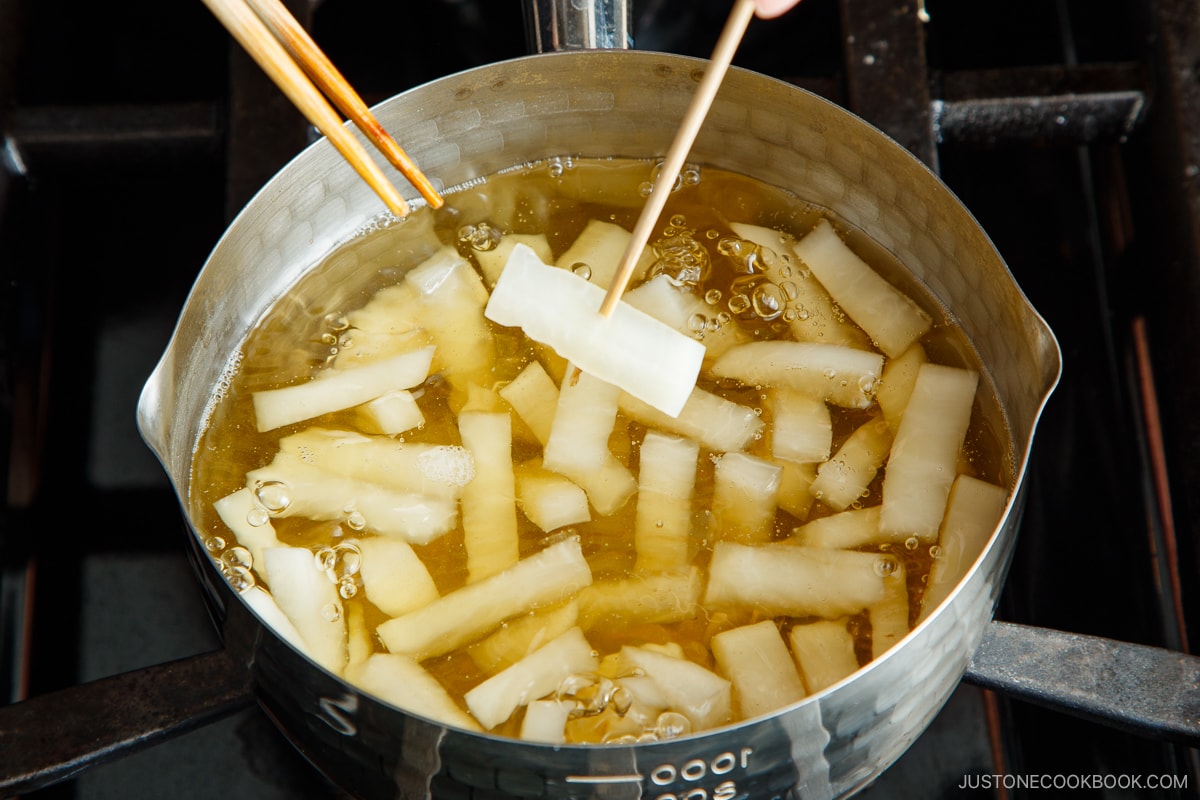
For leafy vegetables and mushrooms, you can add them to already simmering dashi (with or without other cooked ingredients) and cook for a few minutes.

Besides tofu and wakame seaweed, you can add seasonal and year-round ingredients to your miso soup. Check out a collection of seasonal miso soup recipes on Just One Cookbook.
Health Benefits of Miso Soup
Japanese people drink miso soup daily, as we believe this delicious and healing soup is a gateway to excellent health. Much like green tea, you can say miso soup is the elixir of the Japanese diet. Here are just some of the health benefits of miso soup:
- Good source of nutrients. Miso is rich in essential minerals such as copper, manganese, protein, Vitamin K, and zinc. Therefore, drinking a bowl of miso soup daily is like taking a natural supplement for your health.
- Good for bones. Miso soup provides many bone-building minerals like calcium, magnesium, and manganese, which help to reduce the risk of developing osteoporosis.
- Improve heart health. The natural compounds in miso, including Vitamin K2, linoleic acid, and saponin, are known to reduce the risk of heart disease and lower cholesterol.
To fully enjoy the fantastic health benefits of miso soup, make your own miso soup. Instant miso soup may not be as beneficial, as it often contains higher sodium and additional preservatives. However, some reputable brands are available, so be sure to read the label.
Now that you’ve learned how to make miso soup at home, I hope you enjoy this nourishing soup every day!
Popular Miso Soup Recipes

- Homemade Instant Miso Soup
- Vegan Miso Soup
- Vegetable Miso Soup
- Kabocha Miso Soup
- Tonjiru (Pork & Vegetable Miso Soup)
- Clam Soup (Asari Miso Soup)
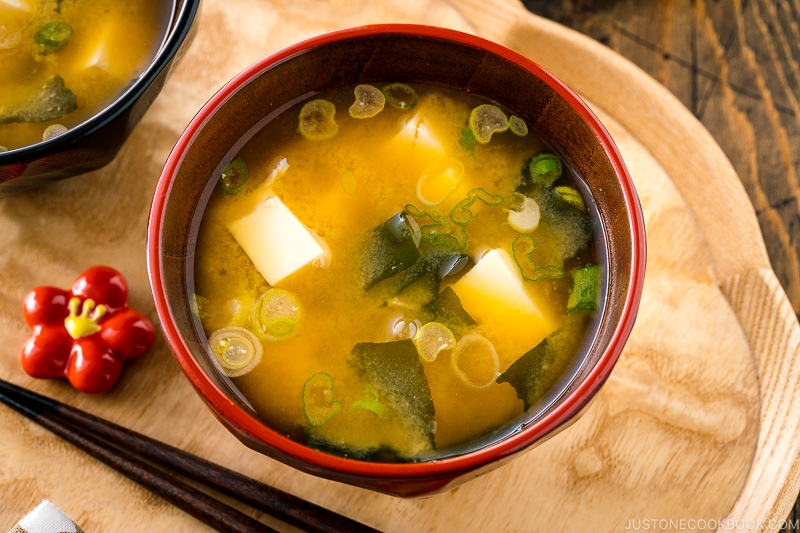
Wish to learn more about Japanese cooking? Sign up for our free newsletter to receive cooking tips & recipe updates! And stay in touch with me on Facebook, Pinterest, YouTube, and Instagram.
Editor’s Note: The post was originally published on Mar 3, 2011. The recipe was revised and updated on June 7, 2022. The post was updated with new images, a new video, and more helpful content on February 2, 2024.
